Impact of National Health Policies on Chronic Diseases and Nursing
VerifiedAdded on 2023/01/10
|10
|2876
|33
Essay
AI Summary
This essay provides a comprehensive overview of national health policies in Australia, specifically addressing their impact on chronic diseases and the healthcare system. It examines the role of federal and state policies, the National Health Policy, and the National Strategic Framework for chronic conditions. The essay highlights how these policies affect older people, who are particularly vulnerable to chronic conditions like cardiovascular disorders and diabetes. It explores the importance of coordinated care, risk factors, and preventive measures. Furthermore, it discusses the guidelines and programs in place to support the treatment, prevention, and management of chronic conditions, including funding for research and evidence-based practices. The essay also links these policies to nursing practice, emphasizing the nurses' role in influencing the healthcare system and improving patient outcomes. It concludes by summarizing the effects of these policies on the aged population and the healthcare system and highlighting the need for accountability in implementing these policies.
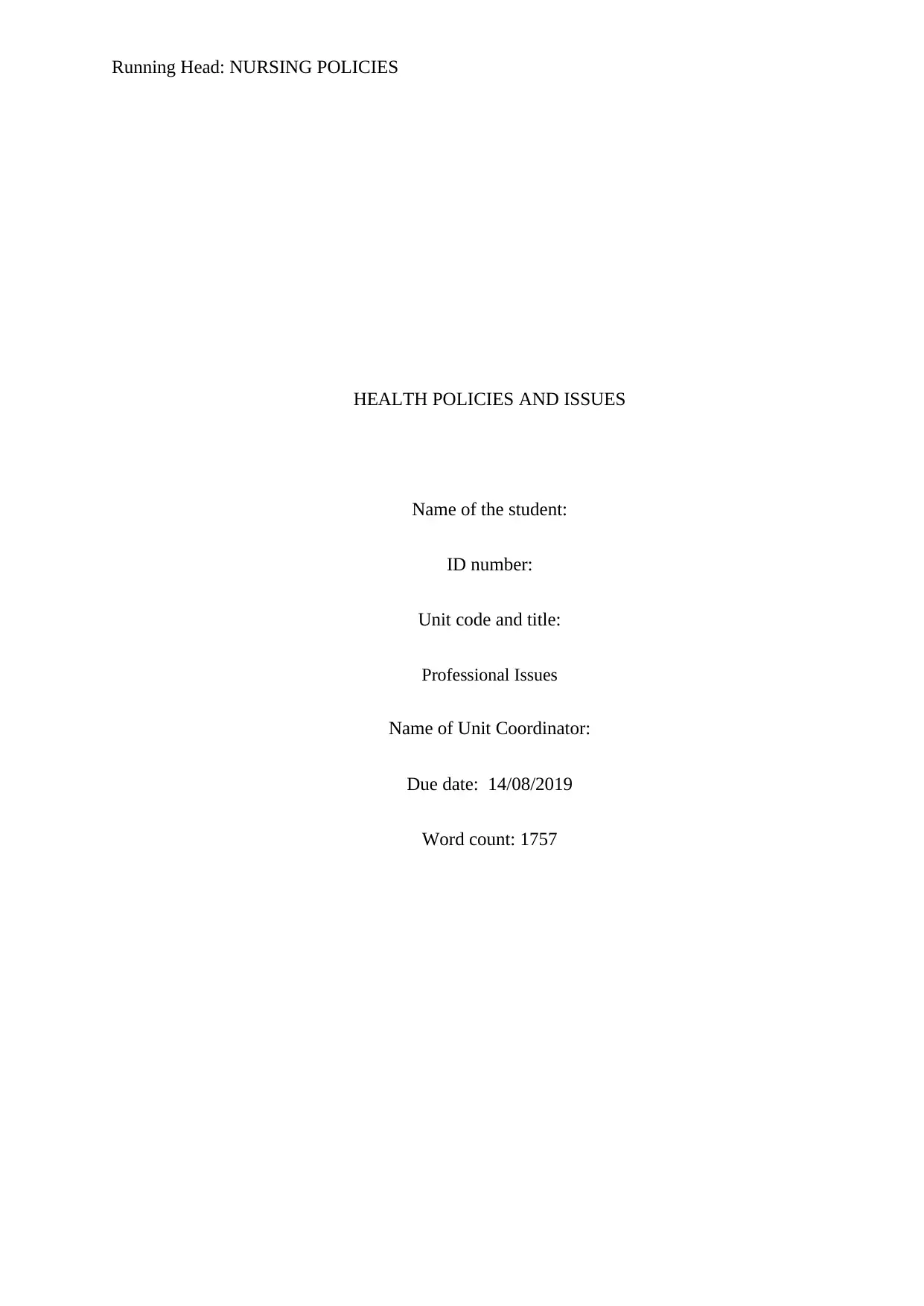
Running Head: NURSING POLICIES
HEALTH POLICIES AND ISSUES
Name of the student:
ID number:
Unit code and title:
Professional Issues
Name of Unit Coordinator:
Due date: 14/08/2019
Word count: 1757
HEALTH POLICIES AND ISSUES
Name of the student:
ID number:
Unit code and title:
Professional Issues
Name of Unit Coordinator:
Due date: 14/08/2019
Word count: 1757
Paraphrase This Document
Need a fresh take? Get an instant paraphrase of this document with our AI Paraphraser
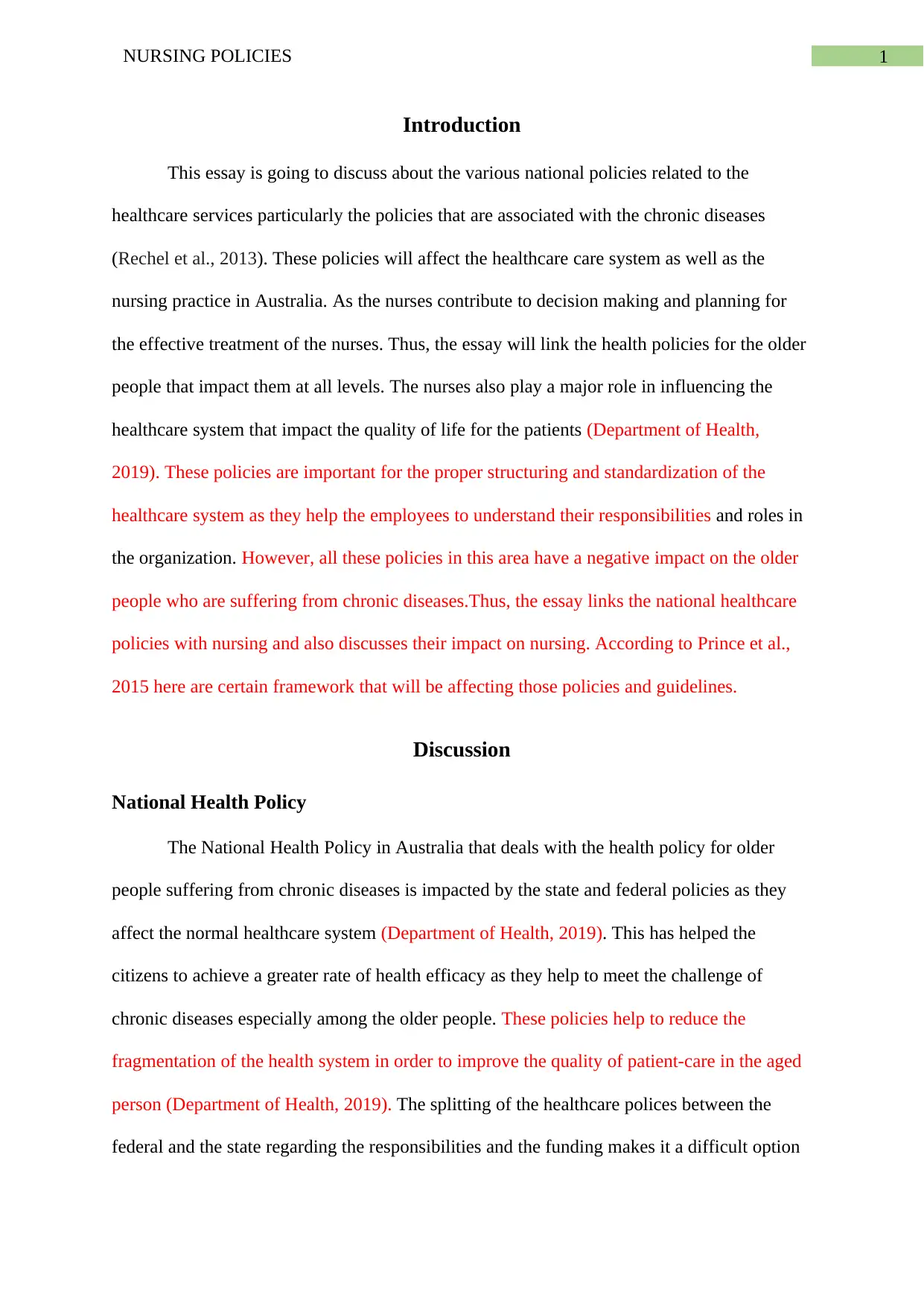
1NURSING POLICIES
Introduction
This essay is going to discuss about the various national policies related to the
healthcare services particularly the policies that are associated with the chronic diseases
(Rechel et al., 2013). These policies will affect the healthcare care system as well as the
nursing practice in Australia. As the nurses contribute to decision making and planning for
the effective treatment of the nurses. Thus, the essay will link the health policies for the older
people that impact them at all levels. The nurses also play a major role in influencing the
healthcare system that impact the quality of life for the patients (Department of Health,
2019). These policies are important for the proper structuring and standardization of the
healthcare system as they help the employees to understand their responsibilities and roles in
the organization. However, all these policies in this area have a negative impact on the older
people who are suffering from chronic diseases.Thus, the essay links the national healthcare
policies with nursing and also discusses their impact on nursing. According to Prince et al.,
2015 here are certain framework that will be affecting those policies and guidelines.
Discussion
National Health Policy
The National Health Policy in Australia that deals with the health policy for older
people suffering from chronic diseases is impacted by the state and federal policies as they
affect the normal healthcare system (Department of Health, 2019). This has helped the
citizens to achieve a greater rate of health efficacy as they help to meet the challenge of
chronic diseases especially among the older people. These policies help to reduce the
fragmentation of the health system in order to improve the quality of patient-care in the aged
person (Department of Health, 2019). The splitting of the healthcare polices between the
federal and the state regarding the responsibilities and the funding makes it a difficult option
Introduction
This essay is going to discuss about the various national policies related to the
healthcare services particularly the policies that are associated with the chronic diseases
(Rechel et al., 2013). These policies will affect the healthcare care system as well as the
nursing practice in Australia. As the nurses contribute to decision making and planning for
the effective treatment of the nurses. Thus, the essay will link the health policies for the older
people that impact them at all levels. The nurses also play a major role in influencing the
healthcare system that impact the quality of life for the patients (Department of Health,
2019). These policies are important for the proper structuring and standardization of the
healthcare system as they help the employees to understand their responsibilities and roles in
the organization. However, all these policies in this area have a negative impact on the older
people who are suffering from chronic diseases.Thus, the essay links the national healthcare
policies with nursing and also discusses their impact on nursing. According to Prince et al.,
2015 here are certain framework that will be affecting those policies and guidelines.
Discussion
National Health Policy
The National Health Policy in Australia that deals with the health policy for older
people suffering from chronic diseases is impacted by the state and federal policies as they
affect the normal healthcare system (Department of Health, 2019). This has helped the
citizens to achieve a greater rate of health efficacy as they help to meet the challenge of
chronic diseases especially among the older people. These policies help to reduce the
fragmentation of the health system in order to improve the quality of patient-care in the aged
person (Department of Health, 2019). The splitting of the healthcare polices between the
federal and the state regarding the responsibilities and the funding makes it a difficult option
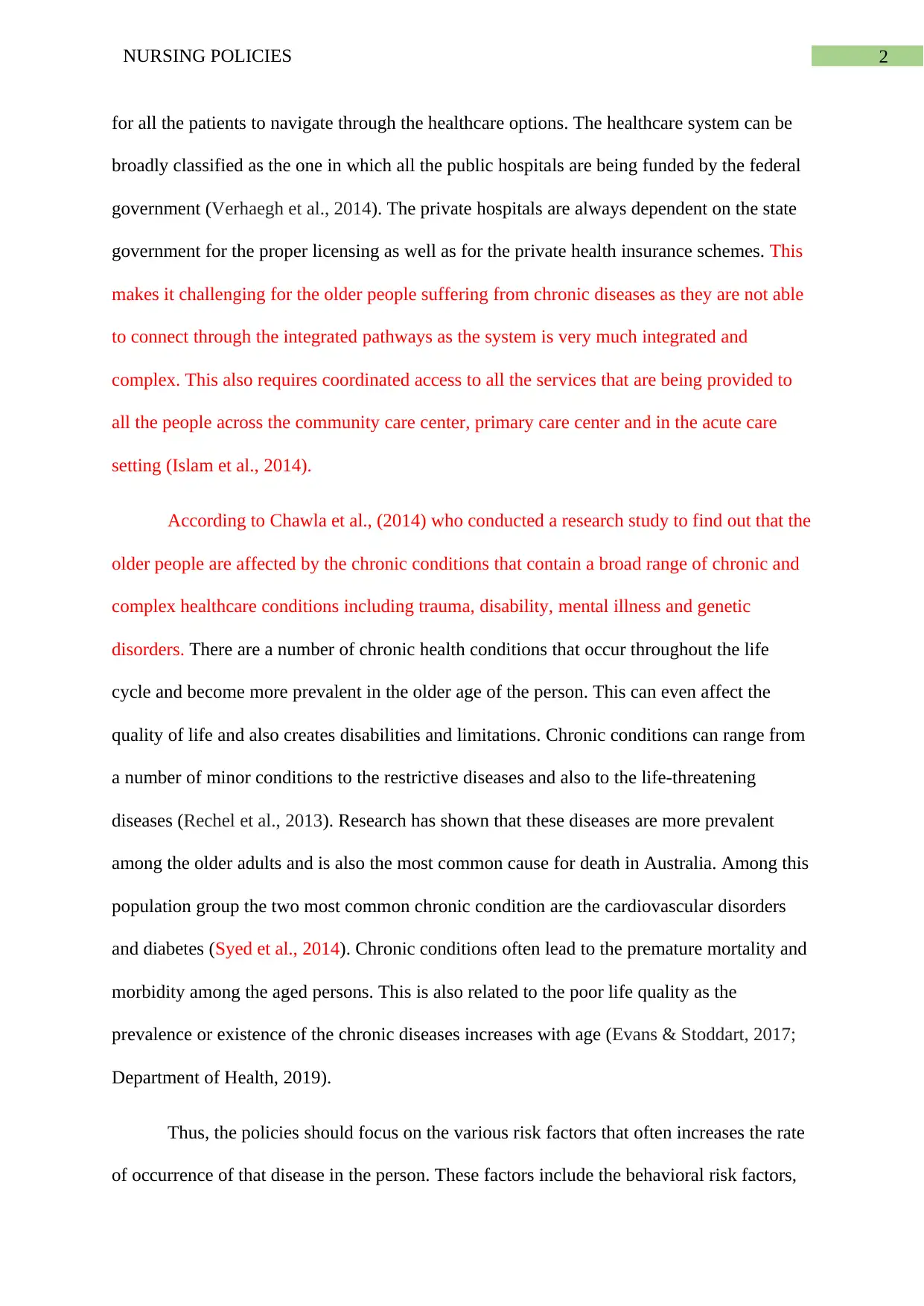
2NURSING POLICIES
for all the patients to navigate through the healthcare options. The healthcare system can be
broadly classified as the one in which all the public hospitals are being funded by the federal
government (Verhaegh et al., 2014). The private hospitals are always dependent on the state
government for the proper licensing as well as for the private health insurance schemes. This
makes it challenging for the older people suffering from chronic diseases as they are not able
to connect through the integrated pathways as the system is very much integrated and
complex. This also requires coordinated access to all the services that are being provided to
all the people across the community care center, primary care center and in the acute care
setting (Islam et al., 2014).
According to Chawla et al., (2014) who conducted a research study to find out that the
older people are affected by the chronic conditions that contain a broad range of chronic and
complex healthcare conditions including trauma, disability, mental illness and genetic
disorders. There are a number of chronic health conditions that occur throughout the life
cycle and become more prevalent in the older age of the person. This can even affect the
quality of life and also creates disabilities and limitations. Chronic conditions can range from
a number of minor conditions to the restrictive diseases and also to the life-threatening
diseases (Rechel et al., 2013). Research has shown that these diseases are more prevalent
among the older adults and is also the most common cause for death in Australia. Among this
population group the two most common chronic condition are the cardiovascular disorders
and diabetes (Syed et al., 2014). Chronic conditions often lead to the premature mortality and
morbidity among the aged persons. This is also related to the poor life quality as the
prevalence or existence of the chronic diseases increases with age (Evans & Stoddart, 2017;
Department of Health, 2019).
Thus, the policies should focus on the various risk factors that often increases the rate
of occurrence of that disease in the person. These factors include the behavioral risk factors,
for all the patients to navigate through the healthcare options. The healthcare system can be
broadly classified as the one in which all the public hospitals are being funded by the federal
government (Verhaegh et al., 2014). The private hospitals are always dependent on the state
government for the proper licensing as well as for the private health insurance schemes. This
makes it challenging for the older people suffering from chronic diseases as they are not able
to connect through the integrated pathways as the system is very much integrated and
complex. This also requires coordinated access to all the services that are being provided to
all the people across the community care center, primary care center and in the acute care
setting (Islam et al., 2014).
According to Chawla et al., (2014) who conducted a research study to find out that the
older people are affected by the chronic conditions that contain a broad range of chronic and
complex healthcare conditions including trauma, disability, mental illness and genetic
disorders. There are a number of chronic health conditions that occur throughout the life
cycle and become more prevalent in the older age of the person. This can even affect the
quality of life and also creates disabilities and limitations. Chronic conditions can range from
a number of minor conditions to the restrictive diseases and also to the life-threatening
diseases (Rechel et al., 2013). Research has shown that these diseases are more prevalent
among the older adults and is also the most common cause for death in Australia. Among this
population group the two most common chronic condition are the cardiovascular disorders
and diabetes (Syed et al., 2014). Chronic conditions often lead to the premature mortality and
morbidity among the aged persons. This is also related to the poor life quality as the
prevalence or existence of the chronic diseases increases with age (Evans & Stoddart, 2017;
Department of Health, 2019).
Thus, the policies should focus on the various risk factors that often increases the rate
of occurrence of that disease in the person. These factors include the behavioral risk factors,
⊘ This is a preview!⊘
Do you want full access?
Subscribe today to unlock all pages.

Trusted by 1+ million students worldwide
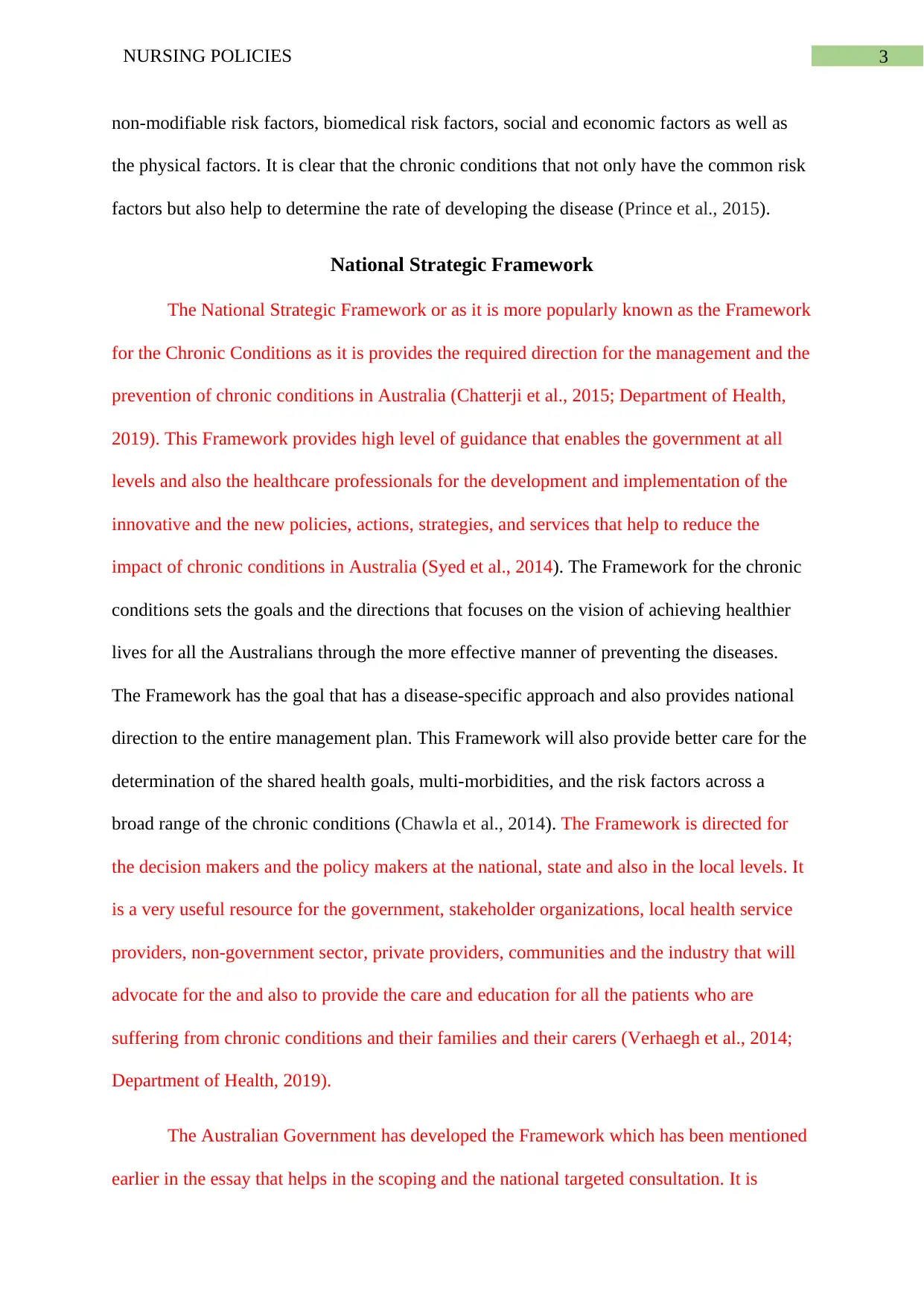
3NURSING POLICIES
non-modifiable risk factors, biomedical risk factors, social and economic factors as well as
the physical factors. It is clear that the chronic conditions that not only have the common risk
factors but also help to determine the rate of developing the disease (Prince et al., 2015).
National Strategic Framework
The National Strategic Framework or as it is more popularly known as the Framework
for the Chronic Conditions as it is provides the required direction for the management and the
prevention of chronic conditions in Australia (Chatterji et al., 2015; Department of Health,
2019). This Framework provides high level of guidance that enables the government at all
levels and also the healthcare professionals for the development and implementation of the
innovative and the new policies, actions, strategies, and services that help to reduce the
impact of chronic conditions in Australia (Syed et al., 2014). The Framework for the chronic
conditions sets the goals and the directions that focuses on the vision of achieving healthier
lives for all the Australians through the more effective manner of preventing the diseases.
The Framework has the goal that has a disease-specific approach and also provides national
direction to the entire management plan. This Framework will also provide better care for the
determination of the shared health goals, multi-morbidities, and the risk factors across a
broad range of the chronic conditions (Chawla et al., 2014). The Framework is directed for
the decision makers and the policy makers at the national, state and also in the local levels. It
is a very useful resource for the government, stakeholder organizations, local health service
providers, non-government sector, private providers, communities and the industry that will
advocate for the and also to provide the care and education for all the patients who are
suffering from chronic conditions and their families and their carers (Verhaegh et al., 2014;
Department of Health, 2019).
The Australian Government has developed the Framework which has been mentioned
earlier in the essay that helps in the scoping and the national targeted consultation. It is
non-modifiable risk factors, biomedical risk factors, social and economic factors as well as
the physical factors. It is clear that the chronic conditions that not only have the common risk
factors but also help to determine the rate of developing the disease (Prince et al., 2015).
National Strategic Framework
The National Strategic Framework or as it is more popularly known as the Framework
for the Chronic Conditions as it is provides the required direction for the management and the
prevention of chronic conditions in Australia (Chatterji et al., 2015; Department of Health,
2019). This Framework provides high level of guidance that enables the government at all
levels and also the healthcare professionals for the development and implementation of the
innovative and the new policies, actions, strategies, and services that help to reduce the
impact of chronic conditions in Australia (Syed et al., 2014). The Framework for the chronic
conditions sets the goals and the directions that focuses on the vision of achieving healthier
lives for all the Australians through the more effective manner of preventing the diseases.
The Framework has the goal that has a disease-specific approach and also provides national
direction to the entire management plan. This Framework will also provide better care for the
determination of the shared health goals, multi-morbidities, and the risk factors across a
broad range of the chronic conditions (Chawla et al., 2014). The Framework is directed for
the decision makers and the policy makers at the national, state and also in the local levels. It
is a very useful resource for the government, stakeholder organizations, local health service
providers, non-government sector, private providers, communities and the industry that will
advocate for the and also to provide the care and education for all the patients who are
suffering from chronic conditions and their families and their carers (Verhaegh et al., 2014;
Department of Health, 2019).
The Australian Government has developed the Framework which has been mentioned
earlier in the essay that helps in the scoping and the national targeted consultation. It is
Paraphrase This Document
Need a fresh take? Get an instant paraphrase of this document with our AI Paraphraser
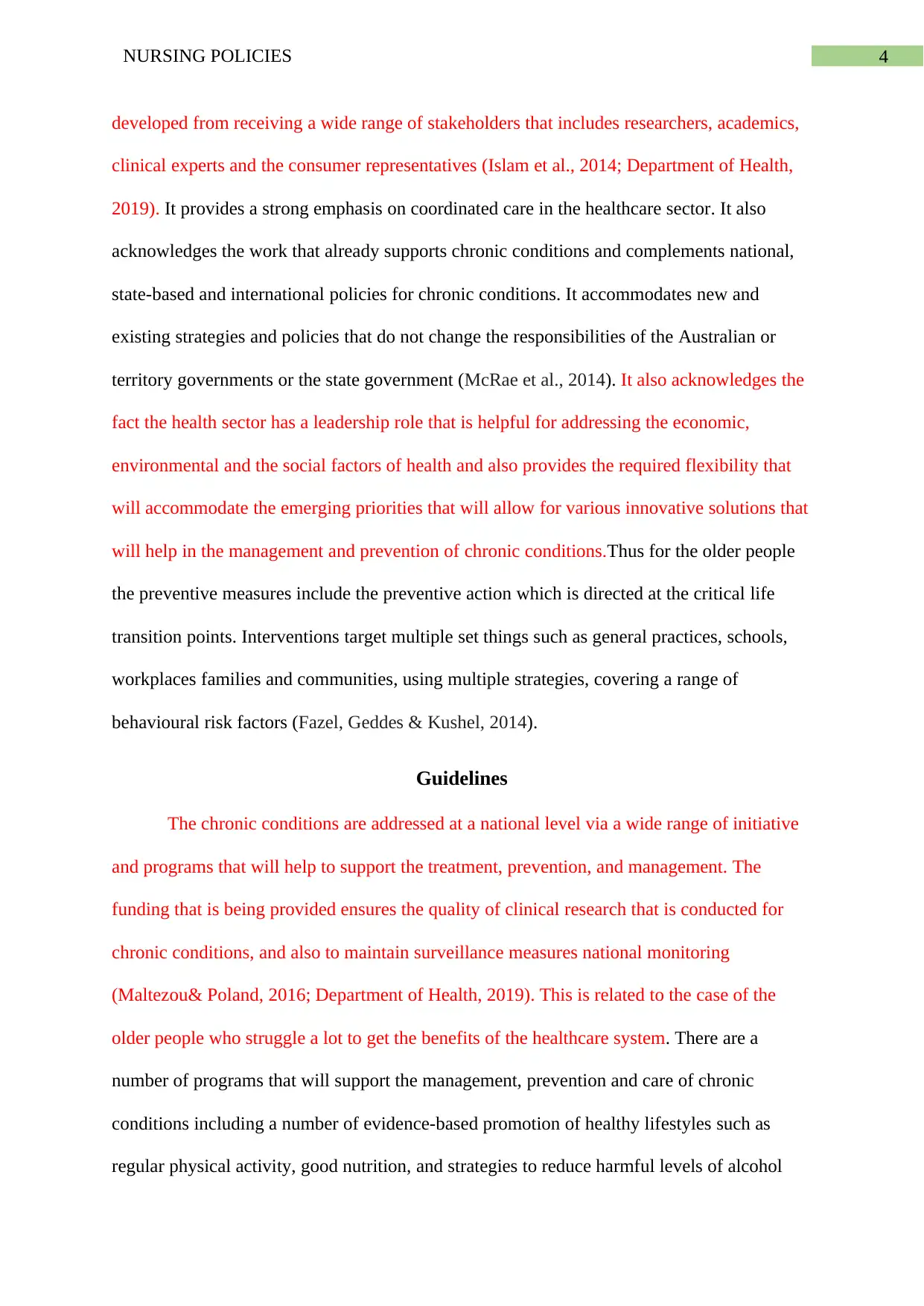
4NURSING POLICIES
developed from receiving a wide range of stakeholders that includes researchers, academics,
clinical experts and the consumer representatives (Islam et al., 2014; Department of Health,
2019). It provides a strong emphasis on coordinated care in the healthcare sector. It also
acknowledges the work that already supports chronic conditions and complements national,
state-based and international policies for chronic conditions. It accommodates new and
existing strategies and policies that do not change the responsibilities of the Australian or
territory governments or the state government (McRae et al., 2014). It also acknowledges the
fact the health sector has a leadership role that is helpful for addressing the economic,
environmental and the social factors of health and also provides the required flexibility that
will accommodate the emerging priorities that will allow for various innovative solutions that
will help in the management and prevention of chronic conditions.Thus for the older people
the preventive measures include the preventive action which is directed at the critical life
transition points. Interventions target multiple set things such as general practices, schools,
workplaces families and communities, using multiple strategies, covering a range of
behavioural risk factors (Fazel, Geddes & Kushel, 2014).
Guidelines
The chronic conditions are addressed at a national level via a wide range of initiative
and programs that will help to support the treatment, prevention, and management. The
funding that is being provided ensures the quality of clinical research that is conducted for
chronic conditions, and also to maintain surveillance measures national monitoring
(Maltezou& Poland, 2016; Department of Health, 2019). This is related to the case of the
older people who struggle a lot to get the benefits of the healthcare system. There are a
number of programs that will support the management, prevention and care of chronic
conditions including a number of evidence-based promotion of healthy lifestyles such as
regular physical activity, good nutrition, and strategies to reduce harmful levels of alcohol
developed from receiving a wide range of stakeholders that includes researchers, academics,
clinical experts and the consumer representatives (Islam et al., 2014; Department of Health,
2019). It provides a strong emphasis on coordinated care in the healthcare sector. It also
acknowledges the work that already supports chronic conditions and complements national,
state-based and international policies for chronic conditions. It accommodates new and
existing strategies and policies that do not change the responsibilities of the Australian or
territory governments or the state government (McRae et al., 2014). It also acknowledges the
fact the health sector has a leadership role that is helpful for addressing the economic,
environmental and the social factors of health and also provides the required flexibility that
will accommodate the emerging priorities that will allow for various innovative solutions that
will help in the management and prevention of chronic conditions.Thus for the older people
the preventive measures include the preventive action which is directed at the critical life
transition points. Interventions target multiple set things such as general practices, schools,
workplaces families and communities, using multiple strategies, covering a range of
behavioural risk factors (Fazel, Geddes & Kushel, 2014).
Guidelines
The chronic conditions are addressed at a national level via a wide range of initiative
and programs that will help to support the treatment, prevention, and management. The
funding that is being provided ensures the quality of clinical research that is conducted for
chronic conditions, and also to maintain surveillance measures national monitoring
(Maltezou& Poland, 2016; Department of Health, 2019). This is related to the case of the
older people who struggle a lot to get the benefits of the healthcare system. There are a
number of programs that will support the management, prevention and care of chronic
conditions including a number of evidence-based promotion of healthy lifestyles such as
regular physical activity, good nutrition, and strategies to reduce harmful levels of alcohol
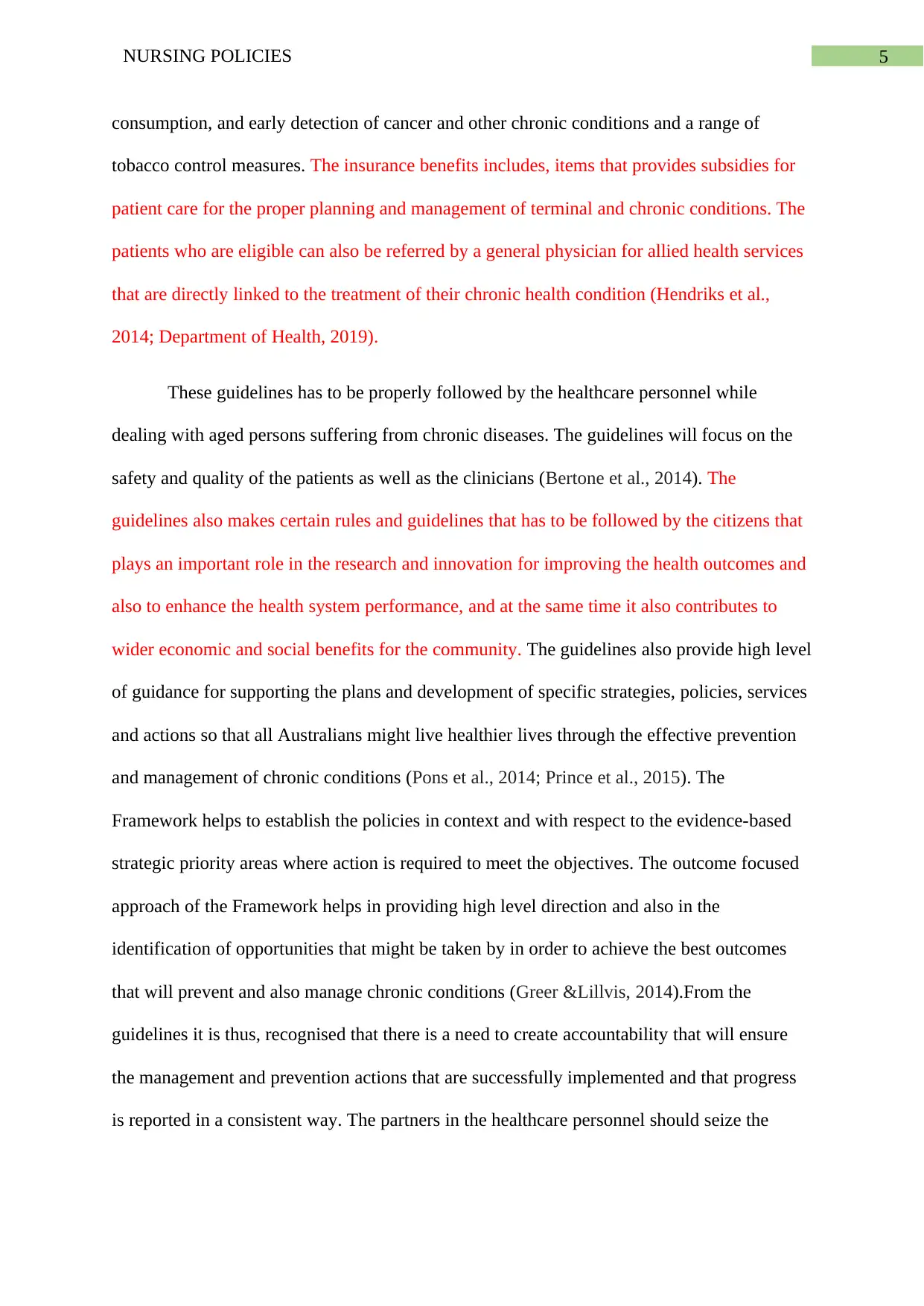
5NURSING POLICIES
consumption, and early detection of cancer and other chronic conditions and a range of
tobacco control measures. The insurance benefits includes, items that provides subsidies for
patient care for the proper planning and management of terminal and chronic conditions. The
patients who are eligible can also be referred by a general physician for allied health services
that are directly linked to the treatment of their chronic health condition (Hendriks et al.,
2014; Department of Health, 2019).
These guidelines has to be properly followed by the healthcare personnel while
dealing with aged persons suffering from chronic diseases. The guidelines will focus on the
safety and quality of the patients as well as the clinicians (Bertone et al., 2014). The
guidelines also makes certain rules and guidelines that has to be followed by the citizens that
plays an important role in the research and innovation for improving the health outcomes and
also to enhance the health system performance, and at the same time it also contributes to
wider economic and social benefits for the community. The guidelines also provide high level
of guidance for supporting the plans and development of specific strategies, policies, services
and actions so that all Australians might live healthier lives through the effective prevention
and management of chronic conditions (Pons et al., 2014; Prince et al., 2015). The
Framework helps to establish the policies in context and with respect to the evidence-based
strategic priority areas where action is required to meet the objectives. The outcome focused
approach of the Framework helps in providing high level direction and also in the
identification of opportunities that might be taken by in order to achieve the best outcomes
that will prevent and also manage chronic conditions (Greer &Lillvis, 2014).From the
guidelines it is thus, recognised that there is a need to create accountability that will ensure
the management and prevention actions that are successfully implemented and that progress
is reported in a consistent way. The partners in the healthcare personnel should seize the
consumption, and early detection of cancer and other chronic conditions and a range of
tobacco control measures. The insurance benefits includes, items that provides subsidies for
patient care for the proper planning and management of terminal and chronic conditions. The
patients who are eligible can also be referred by a general physician for allied health services
that are directly linked to the treatment of their chronic health condition (Hendriks et al.,
2014; Department of Health, 2019).
These guidelines has to be properly followed by the healthcare personnel while
dealing with aged persons suffering from chronic diseases. The guidelines will focus on the
safety and quality of the patients as well as the clinicians (Bertone et al., 2014). The
guidelines also makes certain rules and guidelines that has to be followed by the citizens that
plays an important role in the research and innovation for improving the health outcomes and
also to enhance the health system performance, and at the same time it also contributes to
wider economic and social benefits for the community. The guidelines also provide high level
of guidance for supporting the plans and development of specific strategies, policies, services
and actions so that all Australians might live healthier lives through the effective prevention
and management of chronic conditions (Pons et al., 2014; Prince et al., 2015). The
Framework helps to establish the policies in context and with respect to the evidence-based
strategic priority areas where action is required to meet the objectives. The outcome focused
approach of the Framework helps in providing high level direction and also in the
identification of opportunities that might be taken by in order to achieve the best outcomes
that will prevent and also manage chronic conditions (Greer &Lillvis, 2014).From the
guidelines it is thus, recognised that there is a need to create accountability that will ensure
the management and prevention actions that are successfully implemented and that progress
is reported in a consistent way. The partners in the healthcare personnel should seize the
⊘ This is a preview!⊘
Do you want full access?
Subscribe today to unlock all pages.

Trusted by 1+ million students worldwide
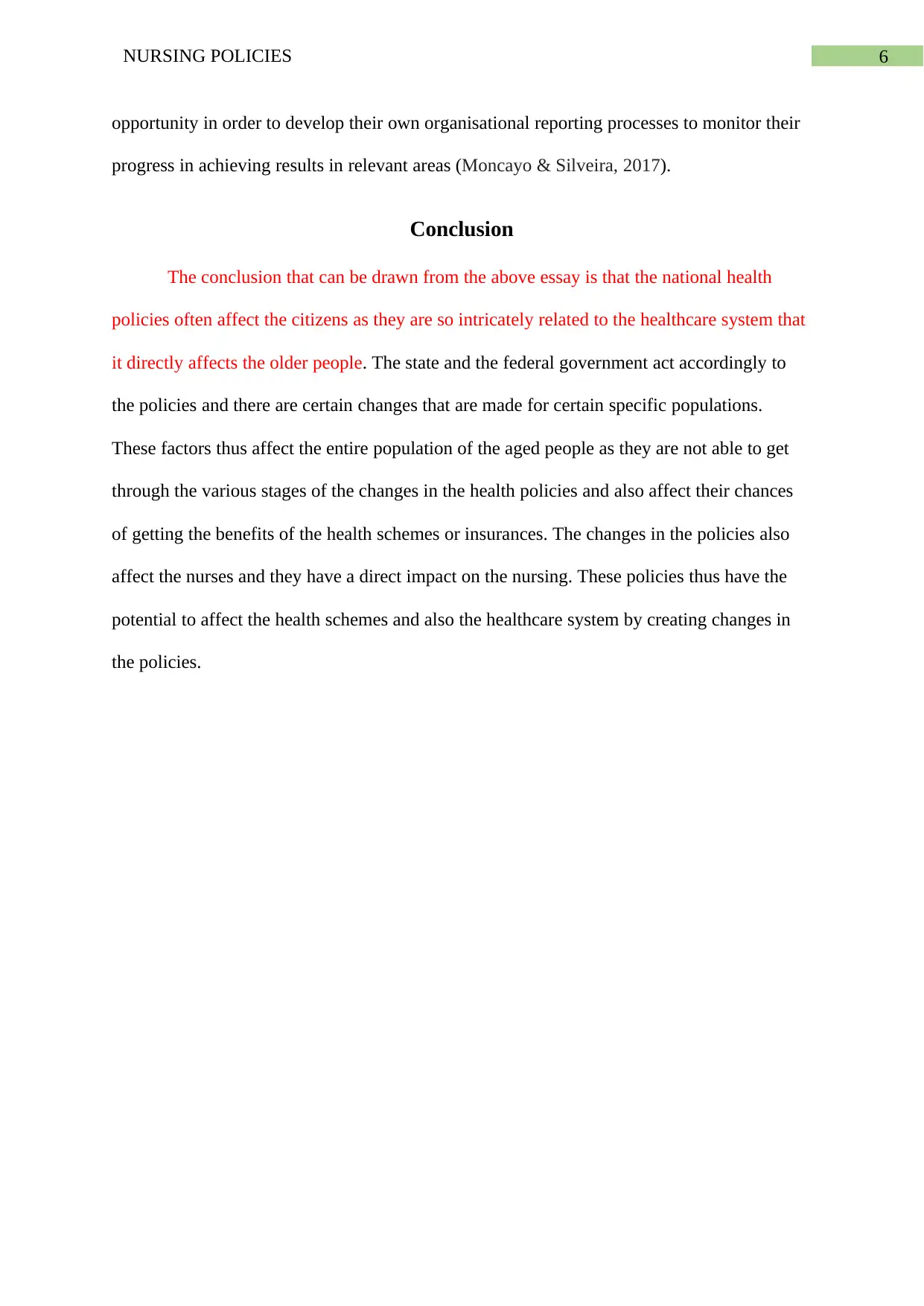
6NURSING POLICIES
opportunity in order to develop their own organisational reporting processes to monitor their
progress in achieving results in relevant areas (Moncayo & Silveira, 2017).
Conclusion
The conclusion that can be drawn from the above essay is that the national health
policies often affect the citizens as they are so intricately related to the healthcare system that
it directly affects the older people. The state and the federal government act accordingly to
the policies and there are certain changes that are made for certain specific populations.
These factors thus affect the entire population of the aged people as they are not able to get
through the various stages of the changes in the health policies and also affect their chances
of getting the benefits of the health schemes or insurances. The changes in the policies also
affect the nurses and they have a direct impact on the nursing. These policies thus have the
potential to affect the health schemes and also the healthcare system by creating changes in
the policies.
opportunity in order to develop their own organisational reporting processes to monitor their
progress in achieving results in relevant areas (Moncayo & Silveira, 2017).
Conclusion
The conclusion that can be drawn from the above essay is that the national health
policies often affect the citizens as they are so intricately related to the healthcare system that
it directly affects the older people. The state and the federal government act accordingly to
the policies and there are certain changes that are made for certain specific populations.
These factors thus affect the entire population of the aged people as they are not able to get
through the various stages of the changes in the health policies and also affect their chances
of getting the benefits of the health schemes or insurances. The changes in the policies also
affect the nurses and they have a direct impact on the nursing. These policies thus have the
potential to affect the health schemes and also the healthcare system by creating changes in
the policies.
Paraphrase This Document
Need a fresh take? Get an instant paraphrase of this document with our AI Paraphraser
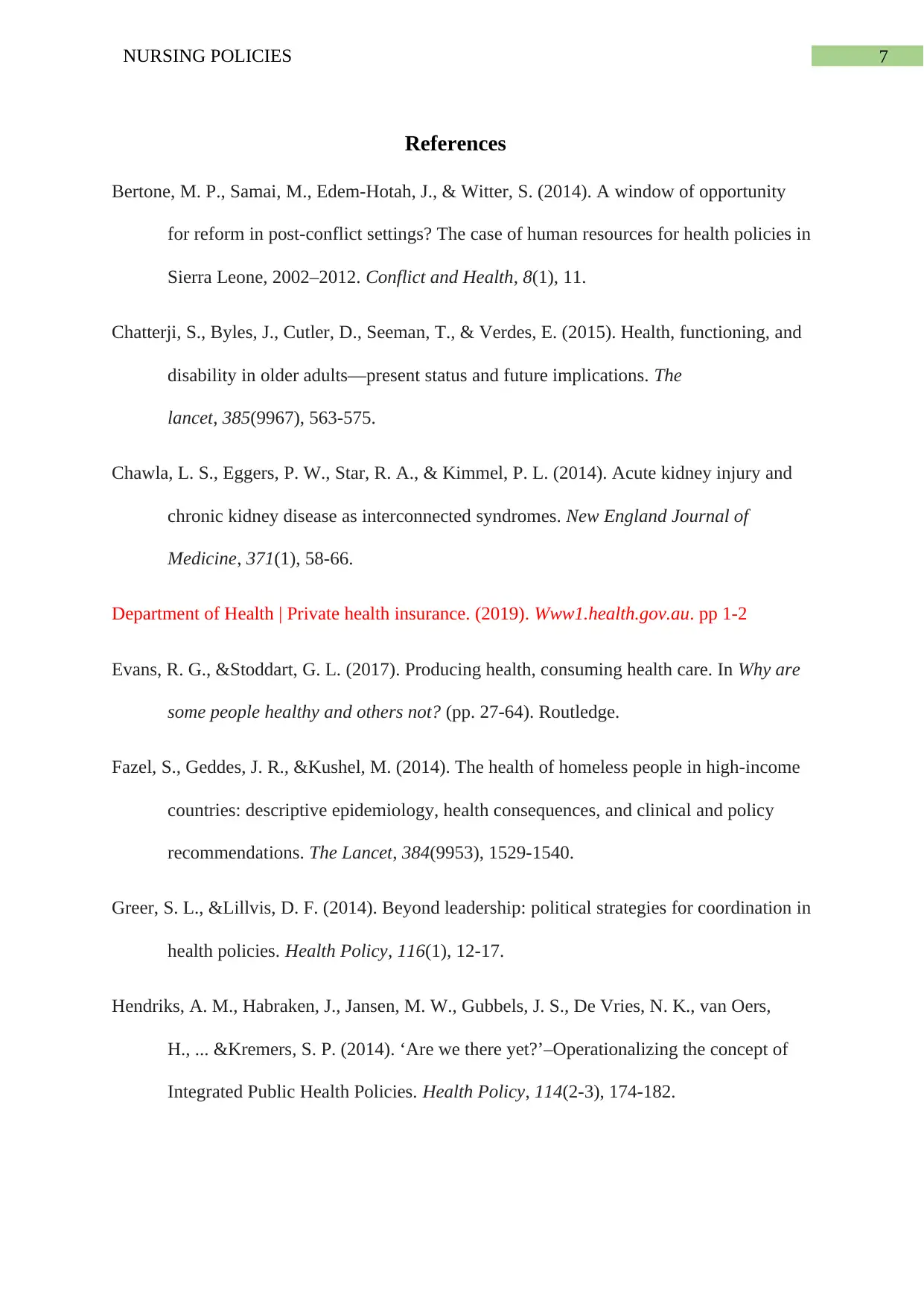
7NURSING POLICIES
References
Bertone, M. P., Samai, M., Edem-Hotah, J., & Witter, S. (2014). A window of opportunity
for reform in post-conflict settings? The case of human resources for health policies in
Sierra Leone, 2002–2012. Conflict and Health, 8(1), 11.
Chatterji, S., Byles, J., Cutler, D., Seeman, T., & Verdes, E. (2015). Health, functioning, and
disability in older adults—present status and future implications. The
lancet, 385(9967), 563-575.
Chawla, L. S., Eggers, P. W., Star, R. A., & Kimmel, P. L. (2014). Acute kidney injury and
chronic kidney disease as interconnected syndromes. New England Journal of
Medicine, 371(1), 58-66.
Department of Health | Private health insurance. (2019). Www1.health.gov.au. pp 1-2
Evans, R. G., &Stoddart, G. L. (2017). Producing health, consuming health care. In Why are
some people healthy and others not? (pp. 27-64). Routledge.
Fazel, S., Geddes, J. R., &Kushel, M. (2014). The health of homeless people in high-income
countries: descriptive epidemiology, health consequences, and clinical and policy
recommendations. The Lancet, 384(9953), 1529-1540.
Greer, S. L., &Lillvis, D. F. (2014). Beyond leadership: political strategies for coordination in
health policies. Health Policy, 116(1), 12-17.
Hendriks, A. M., Habraken, J., Jansen, M. W., Gubbels, J. S., De Vries, N. K., van Oers,
H., ... &Kremers, S. P. (2014). ‘Are we there yet?’–Operationalizing the concept of
Integrated Public Health Policies. Health Policy, 114(2-3), 174-182.
References
Bertone, M. P., Samai, M., Edem-Hotah, J., & Witter, S. (2014). A window of opportunity
for reform in post-conflict settings? The case of human resources for health policies in
Sierra Leone, 2002–2012. Conflict and Health, 8(1), 11.
Chatterji, S., Byles, J., Cutler, D., Seeman, T., & Verdes, E. (2015). Health, functioning, and
disability in older adults—present status and future implications. The
lancet, 385(9967), 563-575.
Chawla, L. S., Eggers, P. W., Star, R. A., & Kimmel, P. L. (2014). Acute kidney injury and
chronic kidney disease as interconnected syndromes. New England Journal of
Medicine, 371(1), 58-66.
Department of Health | Private health insurance. (2019). Www1.health.gov.au. pp 1-2
Evans, R. G., &Stoddart, G. L. (2017). Producing health, consuming health care. In Why are
some people healthy and others not? (pp. 27-64). Routledge.
Fazel, S., Geddes, J. R., &Kushel, M. (2014). The health of homeless people in high-income
countries: descriptive epidemiology, health consequences, and clinical and policy
recommendations. The Lancet, 384(9953), 1529-1540.
Greer, S. L., &Lillvis, D. F. (2014). Beyond leadership: political strategies for coordination in
health policies. Health Policy, 116(1), 12-17.
Hendriks, A. M., Habraken, J., Jansen, M. W., Gubbels, J. S., De Vries, N. K., van Oers,
H., ... &Kremers, S. P. (2014). ‘Are we there yet?’–Operationalizing the concept of
Integrated Public Health Policies. Health Policy, 114(2-3), 174-182.
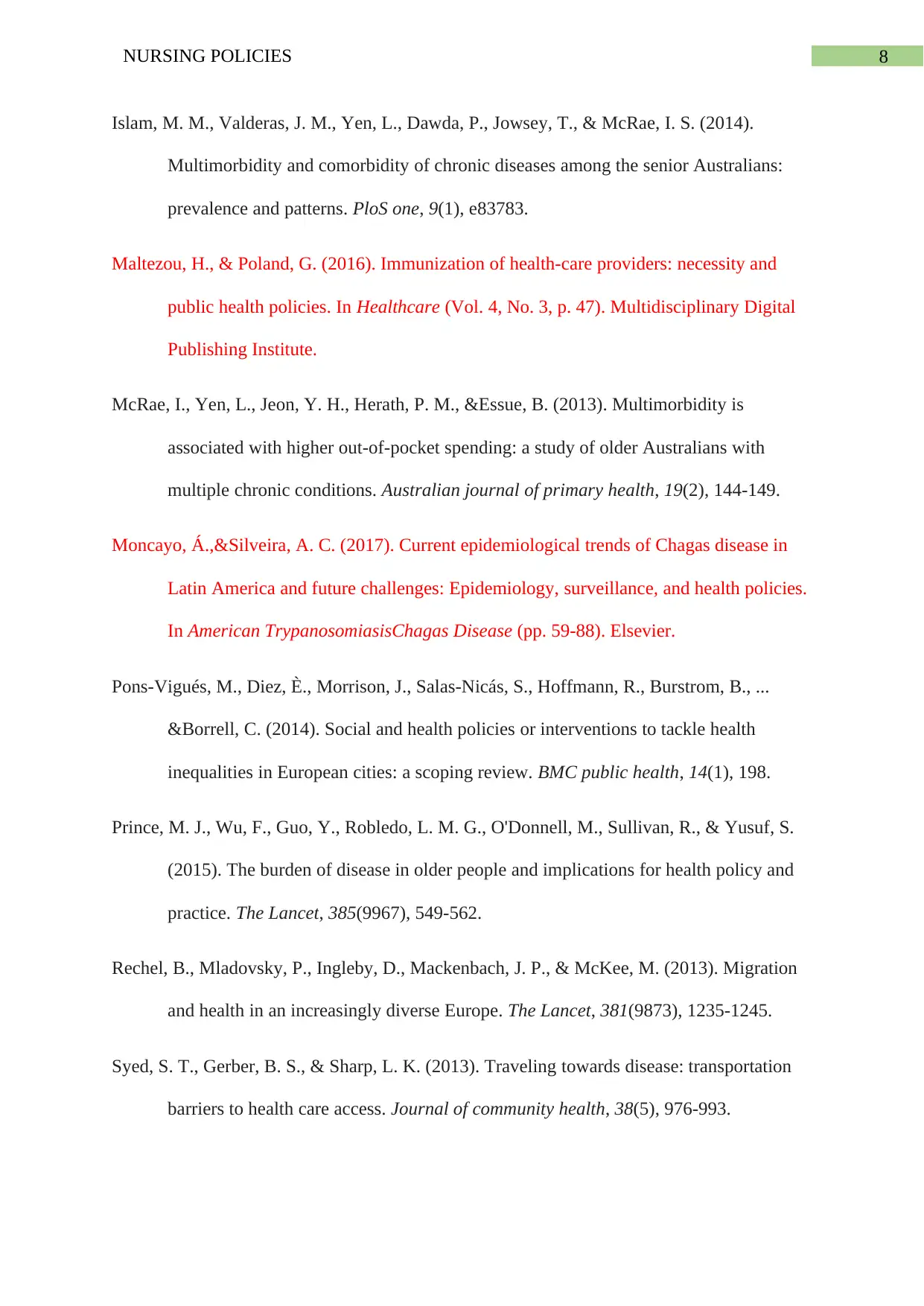
8NURSING POLICIES
Islam, M. M., Valderas, J. M., Yen, L., Dawda, P., Jowsey, T., & McRae, I. S. (2014).
Multimorbidity and comorbidity of chronic diseases among the senior Australians:
prevalence and patterns. PloS one, 9(1), e83783.
Maltezou, H., & Poland, G. (2016). Immunization of health-care providers: necessity and
public health policies. In Healthcare (Vol. 4, No. 3, p. 47). Multidisciplinary Digital
Publishing Institute.
McRae, I., Yen, L., Jeon, Y. H., Herath, P. M., &Essue, B. (2013). Multimorbidity is
associated with higher out-of-pocket spending: a study of older Australians with
multiple chronic conditions. Australian journal of primary health, 19(2), 144-149.
Moncayo, Á.,&Silveira, A. C. (2017). Current epidemiological trends of Chagas disease in
Latin America and future challenges: Epidemiology, surveillance, and health policies.
In American TrypanosomiasisChagas Disease (pp. 59-88). Elsevier.
Pons-Vigués, M., Diez, È., Morrison, J., Salas-Nicás, S., Hoffmann, R., Burstrom, B., ...
&Borrell, C. (2014). Social and health policies or interventions to tackle health
inequalities in European cities: a scoping review. BMC public health, 14(1), 198.
Prince, M. J., Wu, F., Guo, Y., Robledo, L. M. G., O'Donnell, M., Sullivan, R., & Yusuf, S.
(2015). The burden of disease in older people and implications for health policy and
practice. The Lancet, 385(9967), 549-562.
Rechel, B., Mladovsky, P., Ingleby, D., Mackenbach, J. P., & McKee, M. (2013). Migration
and health in an increasingly diverse Europe. The Lancet, 381(9873), 1235-1245.
Syed, S. T., Gerber, B. S., & Sharp, L. K. (2013). Traveling towards disease: transportation
barriers to health care access. Journal of community health, 38(5), 976-993.
Islam, M. M., Valderas, J. M., Yen, L., Dawda, P., Jowsey, T., & McRae, I. S. (2014).
Multimorbidity and comorbidity of chronic diseases among the senior Australians:
prevalence and patterns. PloS one, 9(1), e83783.
Maltezou, H., & Poland, G. (2016). Immunization of health-care providers: necessity and
public health policies. In Healthcare (Vol. 4, No. 3, p. 47). Multidisciplinary Digital
Publishing Institute.
McRae, I., Yen, L., Jeon, Y. H., Herath, P. M., &Essue, B. (2013). Multimorbidity is
associated with higher out-of-pocket spending: a study of older Australians with
multiple chronic conditions. Australian journal of primary health, 19(2), 144-149.
Moncayo, Á.,&Silveira, A. C. (2017). Current epidemiological trends of Chagas disease in
Latin America and future challenges: Epidemiology, surveillance, and health policies.
In American TrypanosomiasisChagas Disease (pp. 59-88). Elsevier.
Pons-Vigués, M., Diez, È., Morrison, J., Salas-Nicás, S., Hoffmann, R., Burstrom, B., ...
&Borrell, C. (2014). Social and health policies or interventions to tackle health
inequalities in European cities: a scoping review. BMC public health, 14(1), 198.
Prince, M. J., Wu, F., Guo, Y., Robledo, L. M. G., O'Donnell, M., Sullivan, R., & Yusuf, S.
(2015). The burden of disease in older people and implications for health policy and
practice. The Lancet, 385(9967), 549-562.
Rechel, B., Mladovsky, P., Ingleby, D., Mackenbach, J. P., & McKee, M. (2013). Migration
and health in an increasingly diverse Europe. The Lancet, 381(9873), 1235-1245.
Syed, S. T., Gerber, B. S., & Sharp, L. K. (2013). Traveling towards disease: transportation
barriers to health care access. Journal of community health, 38(5), 976-993.
⊘ This is a preview!⊘
Do you want full access?
Subscribe today to unlock all pages.

Trusted by 1+ million students worldwide
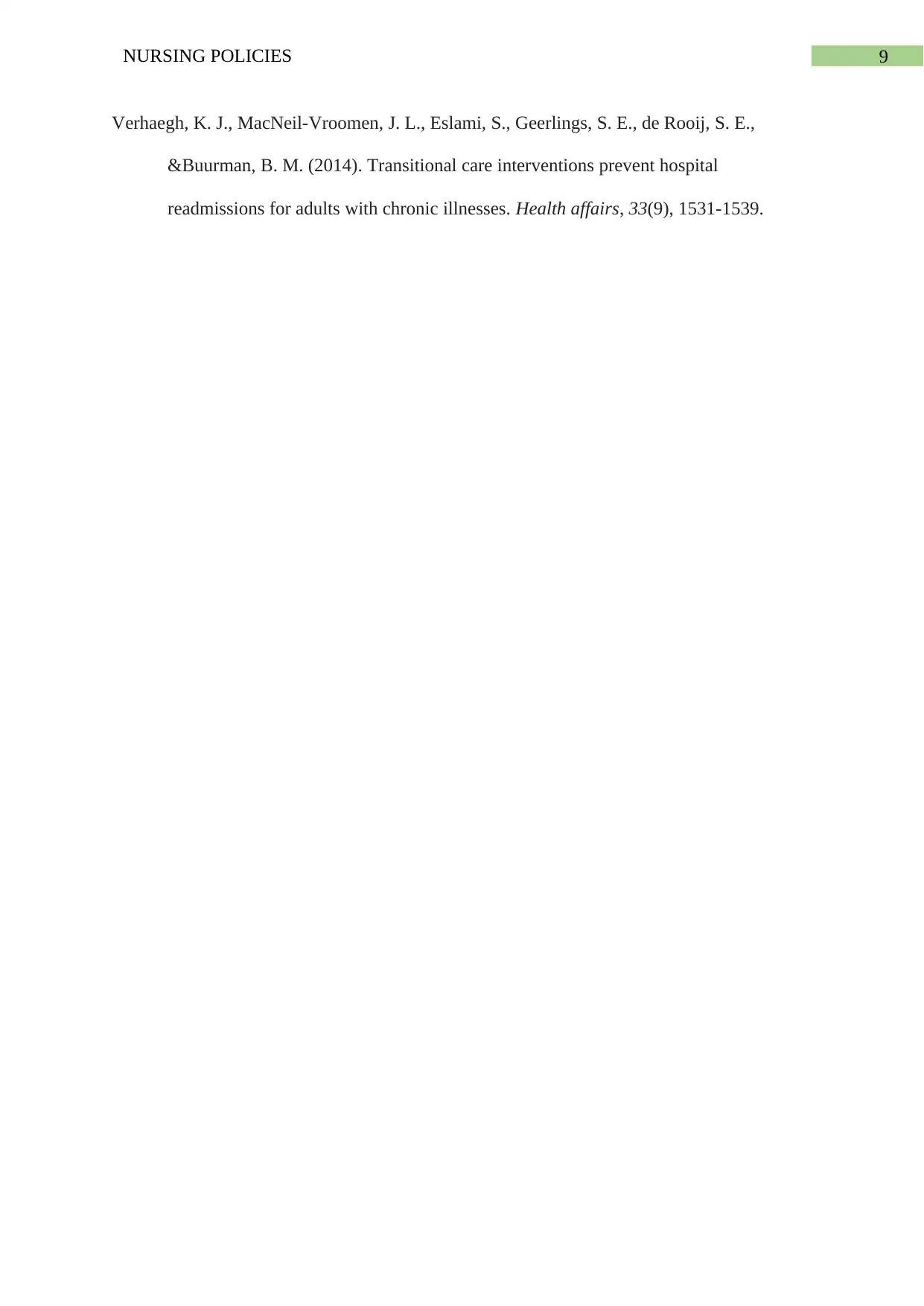
9NURSING POLICIES
Verhaegh, K. J., MacNeil-Vroomen, J. L., Eslami, S., Geerlings, S. E., de Rooij, S. E.,
&Buurman, B. M. (2014). Transitional care interventions prevent hospital
readmissions for adults with chronic illnesses. Health affairs, 33(9), 1531-1539.
Verhaegh, K. J., MacNeil-Vroomen, J. L., Eslami, S., Geerlings, S. E., de Rooij, S. E.,
&Buurman, B. M. (2014). Transitional care interventions prevent hospital
readmissions for adults with chronic illnesses. Health affairs, 33(9), 1531-1539.
1 out of 10
Related Documents
Your All-in-One AI-Powered Toolkit for Academic Success.
+13062052269
info@desklib.com
Available 24*7 on WhatsApp / Email
![[object Object]](/_next/static/media/star-bottom.7253800d.svg)
Unlock your academic potential
Copyright © 2020–2025 A2Z Services. All Rights Reserved. Developed and managed by ZUCOL.





